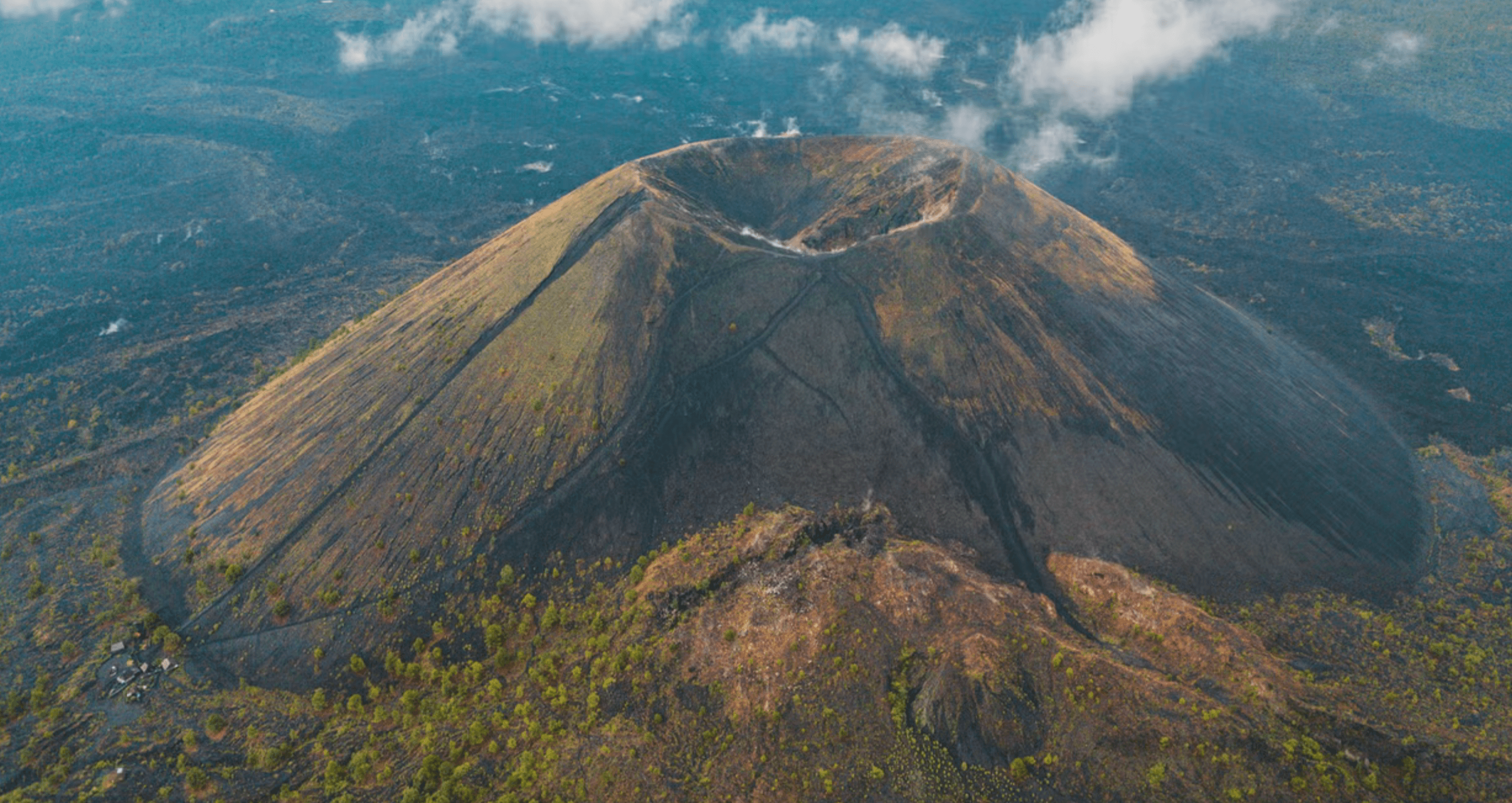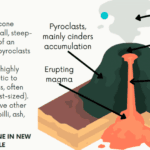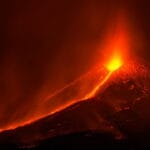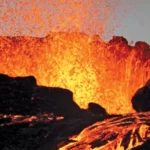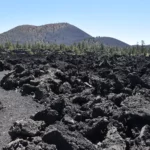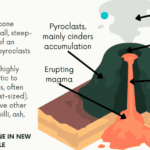Facts About Parícutin Volcano
Imagine this: a farmer in Mexico, going about his day in his cornfield in 1943, when suddenly, the ground begins to shake and smoke. This wasn’t just any ordinary tremor—it was the birth of Parícutin, a volcano that seemingly arose from nowhere.
Parícutin is classified as a monogenetic volcano, meaning it erupts just once before becoming inactive. And erupt it did! Over nine years, this fiery mountain grew to a height exceeding 1,300 feet, spewing out lava and ash in a dramatic display of nature’s power.
The event provided scientists with an unparalleled opportunity: the chance to observe the complete life cycle of a volcano, from its fiery birth to its quiet dormancy. It was an unprecedented event in scientific history.
Tragically, the nearby village of Parícutin wasn’t spared from the volcano’s wrath. The relentless lava flow partially engulfed the town, leaving behind a haunting image of a half-submerged church. Today, these ruins serve as a poignant reminder of the destructive force that nature can unleash.
Today, Parícutin is a dormant landmark in the Mexican state of Michoacán, attracting tourists and geologists who are captivated by its unique story. It’s a testament to the fact that the Earth is a dynamic and ever-evolving entity, capable of both awe-inspiring beauty and immense destruction.
What are some fun facts about Paricutin volcano?
Paricutin isn’t just unique because of its unexpected arrival; it boasts a unique set of characteristics that makes it stand out in the world of geology:
- Remarkably Rapid Growth: Most volcanoes take hundreds, even thousands, of years to form. Paricutin scoffed at convention and grew from a humble cornfield to a towering 1,300 feet in a mere decade.
- Mercifully, No Casualties: Despite its dramatic entrance and fiery displays, Paricutin’s eruption directly caused no human deaths. While it did bury villages, the residents had ample warning and time to evacuate.
- Sleeping Giant, or Just Taking a Nap?: Paricutin has been quiet since 1952, officially classified as dormant. However, scientists acknowledge the possibility of it awakening again and carefully monitor its activity.
- From Cornfield to Tourist Hotspot: What was once a humble cornfield is now a popular tourist destination. People from all over come to witness the raw power of nature and learn about this geological anomaly.
Even More Intriguing Trivia:
- Some experts believe that Paricutin’s quick growth spurt was fueled by a perfect storm of geological factors, including the region’s tectonic activity and the unique composition of the magma beneath the surface.
- Research is ongoing to determine if Paricutin’s eruption had any lasting impact on the local climate and surrounding environment.
Paricutin isn’t just a volcano; it’s a living testament to the incredible forces that shape our planet and a poignant reminder that nature is full of surprises.
What are 5 interesting facts about volcanoes?
Volcanoes are captivating geological formations, capable of both awe-inspiring beauty and destructive power. Let’s delve into some intriguing facts about these fiery giants:
1. Emerging from the Unexpected: Paricutin Volcano, born in a Mexican cornfield in 1943, showcases the unpredictable nature of geological processes.
2. Rapid Ascent and Dramatic Transformation: In just a decade, Paricutin grew from nothing to a staggering height of 1,345 feet, spewing lava and ash and completely transforming the surrounding landscape.
3. The Gentle Giant of Eruptions: Despite its violent eruptions, Paricutin’s activity resulted in no human casualties, a phenomenon that continues to intrigue scientists.
4. A Reminder of Earth’s Ongoing Transformations: Paricutin’s smoldering cone serves as a visual reminder that our planet is in a constant state of flux, capable of producing new geological wonders at any time.
5. The Symphony of Nature’s Fury: Volcanoes are a multi-sensory experience, producing a symphony of sound and fury. The roar of molten rock, the ground-shaking tremors, and the hiss of escaping steam create an unforgettable natural spectacle.
How Old is Paricutin Volcano?
Parícutin, the awe-inspiring volcano that seemingly materialized overnight, might surprise you with its relatively young age. Born in 1943, this geological wonder is a mere 79 years old—younger than most of our grandparents!
It’s a humbling thought to consider: this powerful force of nature, capable of reshaping the landscape, is a mere blink of an eye in geological terms. Yet, in its short lifespan, Parícutin has had an indelible impact on our understanding of volcanic activity.
Its sudden emergence and rapid growth provided scientists with an unprecedented opportunity to witness the complete life cycle of a volcano, from its fiery birth to its current dormant state. It was like having a real-time window into the Earth’s inner workings.
Although Parícutin has been quiet since 1952, it remains a subject of ongoing scientific study. Its existence has fundamentally changed our understanding of volcanic activity and serves as a potent reminder that our planet is in a constant state of change.
How many people died in the Paricutin volcano?
Parícutin, the volcano that literally erupted from a cornfield, might lead you to believe that its fiery rampage resulted in a significant loss of life. Surprisingly, only three people died as a result of the volcano, and their deaths were attributed to lightning strikes caused by the eruption, rather than the lava or ash itself.
While the number of lives lost was relatively low, Parícutin’s impact was still significant. Two entire towns, San Juan Parangaricutiro and Parícutin Viejo, were swallowed whole by the relentless lava flow, forcing thousands of people to evacuate their homes and start anew.
Paricutin provided researchers with a wealth of knowledge. The ability to study its entire life cycle—from its sudden appearance to its dormancy—revolutionized our understanding of how volcanoes form and evolve.
The story of Parícutin serves as a powerful reminder that nature can be both unpredictable and awe-inspiring. It highlights the importance of preparedness and understanding natural disasters, as we never know when or where Mother Earth might decide to shake things up a bit.
Why is Paricutin so special?
What is it about Parícutin, the volcano that surprised a farmer in his cornfield, that makes it so unique in the world of volcanoes? Let’s explore the factors that make Paricutin a geological celebrity.
One of the most significant aspects of Paricutin is that its entire life cycle, from its fiery birth to its current dormancy, occurred within a human lifetime. This rare occurrence gave scientists an unprecedented opportunity to observe and document the complete evolution of a volcano, providing invaluable insights into the forces that shape our planet.
The volcano’s emergence and rapid growth were a spectacle that captivated the world. Its explosive eruptions, which sent ash and lava spewing into the air and dramatically altering the landscape, served as a powerful reminder of the immense power that lies beneath the Earth’s surface.
While Paricutin has been quiet for decades, its legacy as a natural laboratory lives on. The hardened lava flows, layers of ash, and the unique geological formations left behind continue to provide scientists with a wealth of information, allowing them to unlock the mysteries of volcanic activity and the Earth’s inner workings.
Beyond the science, Paricutin holds a special place in the cultural fabric of the local Purépecha people. The volcano’s eruption has been woven into their oral history, passed down through generations as a reminder of the awesome power of nature and their ancestors’ resilience in the face of such events.
Perhaps one of the most inspiring aspects of Paricutin’s story is the return of life to the area. Despite the initial devastation, plants and animals have slowly begun to adapt and thrive in this new, volcanic environment, showcasing nature’s incredible ability to recover and regenerate.
How much did Paricutin rise in 9 years?
Imagine a volcano emerging from a cornfield and, within a timeframe of just nine years, growing taller than the Empire State Building! That’s precisely what Paricutin accomplished, rising to a staggering 424 meters (1,391 feet) above the cornfield where it first appeared. This remarkable growth spurt captivated the scientific community and the world alike.
Paricutin’s classic cinder cone shape, created by the continuous ejection of volcanic ash and cinders, became a textbook example for geologists studying volcanic formations. Researchers flocked to the site to study its eruptions and observe the lava flows in action.
The fact that Paricutin appeared so suddenly and remained active for a significant period gave scientists an unparalleled opportunity to observe the complete life cycle of a cinder cone volcano—a rare occurrence. The well-preserved cone and solidified lava flows continue to be valuable assets for volcanologists, allowing for ongoing research into volcanic processes and the creation of these dramatic landscapes.
How fast did Paricutin grow?
Hold onto your hats, because Paricutin’s growth rate was nothing short of remarkable: in its first year alone, it shot up over 1,000 feet! That’s akin to stacking three Statues of Liberty on top of each other—an incredible testament to the raw power of nature. This dramatic growth continued for nine years, resulting in the towering cinder cone volcano that graces the landscape today.
What fueled this incredible growth spurt? The answer lies in the constant outpouring of lava and ash. Imagine a river of fire, relentlessly flowing and shaping the volcano’s cone. Meanwhile, the wind carried the ash far and wide, blanketing the surrounding area in a gray, snow-like covering. It was a spectacle that could be seen from afar, with its fiery glow visible even in Mexico City, over 180 miles away!
This rapid transformation came at a cost. Two nearby villages, San Juan Parangaricutiro and Parícutin Viejo, were consumed by the relentless lava flow and ash, serving as a poignant reminder of nature’s ability to create and destroy.
Paricutin’s legacy, however, is not just one of destruction. The volcanic soil left behind, enriched by the eruption, proved to be incredibly fertile, allowing new plant life to flourish. Over the years, the area around the volcano has transformed into a haven for wildlife, demonstrating nature’s remarkable resilience.
Is the Paricutin Volcano Quiet or Explosive?
Paricutin, the volcano that made a grand entrance in a cornfield, certainly knew how to make a statement. But once it made its debut, was it a silent simmer or a roaring inferno?
Paricutin is classified as a “monogenetic” volcano, meaning it erupts only once. Think of it as a firecracker—once it goes off, the show is over. And what a show it was! From 1943 to 1952, Paricutin erupted, spewing out ash and lava with unparalleled force, forever altering the surrounding landscape. While no lives were lost directly due to the eruptions, entire villages were buried under molten rock, forcing residents to abandon their homes and seek refuge elsewhere.
When scientists talk about a volcano being “explosive,” they are referring to the intensity and force of the eruption, measured using the Volcanic Explosivity Index (VEI). Paricutin’s eruption ranks as a VEI 4, placing it in the “moderate” category. However, don’t let that fool you—a VEI 4 eruption is still a significant event, capable of widespread destruction and blanketing the region with ash.
The good news is, since Paricutin is monogenetic, it is now considered dormant, like a retired rock star. It gave us one incredible performance, but a repeat performance is improbable.
Paricutin’s eruption provided scientists with a unique opportunity to observe the complete life cycle of a volcano, from birth to dormancy. This front-row seat to nature’s grand show has significantly advanced our understanding of volcanoes and the powerful forces that lie beneath the Earth’s surface.
What does Paricutin mean in english?
Mexico is home to a multitude of volcanoes, each with its own unique history and name. Among these fiery giants is Parícutin, a name that might seem a bit of a mouthful. In English, Parícutin translates to “place of the copper”—a straightforward name that hints at the area’s history and suggests that copper mining was once an important activity in the region.
Why “Place of Copper”?
Volcanoes are born from the depths of the Earth, and their eruptions often bring a variety of minerals and metals closer to the surface. It is highly likely that ancient miners in the area discovered copper deposits near the site where Parícutin eventually made its grand entrance, leading to the name being passed down through generations.
More Than Just a Name
Parícutin, however, is more than just a place of copper; it is a symbol of the unexpected and awe-inspiring power of nature. Its sudden emergence from a peaceful cornfield in 1943, transforming the landscape over nine years of fiery eruptions, serves as a stark reminder that the Earth is constantly evolving.
Sleeping Giant
While Parícutin has been dormant since 1952, meaning it is not currently erupting, scientists acknowledge the possibility that it could reawaken in the future. It serves as a majestic reminder of the Earth’s immense power and a popular destination for adventurous travelers.
A Living Laboratory
Parícutin is not just a spectacle to behold; it is also a treasure trove of information for scientists studying volcanoes. By analyzing its shape, the composition of the rocks it ejected, and the impact on the surrounding environment, researchers can gain a deeper understanding of how volcanoes form, evolve, and impact the areas around them. Parícutin stands as a testament to the ongoing dance between creation and destruction that shapes our planet.
What is a fun fact about the volcano in Mexico?
Mexico is home to a volcano with a backstory that’s wilder than fiction: Paricutin, a volcano that literally popped up overnight in a cornfield.
Picture this: It’s 1943, and a farmer in Mexico is tending to his cornfield. Suddenly, the ground begins to shake, and a fiery mountain begins to rise from the earth right before his eyes—that’s precisely how Paricutin announced its arrival.
And this was no slow, gradual process. Within its first year, this upstart volcano had already grown over 1,000 feet—a geological growth spurt of epic proportions!
Paricutin is classified as a “cinder cone” volcano, known for its steep sides and cone-shaped structure formed by layers of cooled lava and ash. It’s essentially nature’s version of a sandcastle, but on a much grander and more explosive scale.
What makes Paricutin particularly fascinating is that its entire lifespan, from its dramatic birth to its current dormancy, occurred within a human lifetime. This provided scientists with an unprecedented opportunity to witness and document the complete evolution of a volcano, leading to groundbreaking discoveries about these fiery forces of nature.
Today, although Paricutin is considered dormant, the area surrounding it teems with new life. The fertile volcanic soil has given rise to a unique ecosystem, demonstrating nature’s remarkable ability to regenerate and thrive even in the face of devastation.
Prepare to be amazed by the fascinating facts about La Tomatina, the world’s largest tomato fight. Unleash your inner explorer as you delve into the icy wonderland of Perito Moreno Glacier, a magnificent natural marvel.
